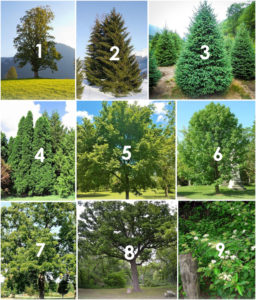Coldwell Banker Neumann Real Estate Brokerage is celebrating Earth Month by giving away free tree saplings.
Let me know which tree you would like and I will drop it off on your porch. The deadline to order is Sunday, April 27th at 8am.
- Silver Maple (Acer saccharinum): The silver maple grows in central and southern Ontario.The silver maple grows quickly — it’s often planted to provide shade or to block unsightly views. Young bark is smooth and grey when young, old bark is shaggy with strips peeling at both ends. Grows to a height of 35 metres with a 100 centimetres trunk diameter. Flowers appear in early to mid-March, growing in clusters that surround a twig. Fruits are pairs of winged seeds though often only one seed per pair develops. • prefers moist soil • Slightly shade tolerant but prefers full sun. • Prefers rich soil • needs plenty of room to grow, not an ideal tree next to city streets.
- Norway Spruce (Picea abies): The Norway spruce is native to Central and Eastern Europe. The Norway Spruce is often used for Christmas trees and only take 3 years to reach an appropriate height. The bark is reddish-brown and roughened with thick scales. Grows to a height of 55 metres with a trunk diameter of 1-1.5 metres. Has single needles that are shiny green. Yields bright pink female flowers and greenish male flowers. • prefers moist soil • full sunshine but tolerates 50% shade • grows in acidic, loamy, moist, sandy, welldrained and clay soils • some draught tolerance.
- White Spruce (Picea glauca): The white spruce is a common tree in the north, but it can grow in southern Ontario. It grows well in the far north and can be found along the arctic tree line. Bark, branches, buds and seeds from the white spruce are a meal for deer, rabbits, porcupines, birds, and small rodents. Bark is loose, scaly, and greyish-brown. Grows to a height of 30 metres with a trunk diameter of 60 centimetres. Needles are about 2 centimetres long and bluish green or green in colour, with a whitish powdery, waxy layer. Cones from the white spruce are 5-7 centimetres long and are light brown. • Tolerates a range of moisture levels • Tolerates shade. • Can grow in almost any soil type. • The white spruce is sensitive to frost damage when young and should be planted in a protected area. It can survive in a range of soil and moisture conditions.
- Eastern White Cedar: Cones from the eastern white cedar are 7 to 12 millimetres long and grow in clumps of 5 or 6 pairs. Small scaly leaves cover the tree’s fan-shaped twigs and are a yellowish-green colour. The bark of the eastern white cedar is thin and shiny when the tree is young, but separates into flat narrow strips as the tree gets older. White-tailed deer eat the twigs of the eastern white cedar during the winter. Size: 15 metres tall, trunk 30 centimetres in diameter Moisture: Prefers moist soil Shade: Tolerates some shade Soil: Grows in a variety of soils, but does not tolerate road salt.
- American Elm (Ulmus americana) American elm is easily recognized by its vase-shaped habit, with one straight trunk splitting into many arching branches. The leaves are oval-shaped, dark green, rough to the touch and have a very asymmetrical base. Tiny flowers appear before the leaves small clusters of circular, winged seeds mature in spring. The American elm was one of our largest native trees before the disease, and most adaptable to rural and urban life. The University of Guelph Arboretum has been identifying large survivors and assembling a gene bank for breeding resistance. Size: Up to 35 m tall Moisture: Prefers moist but adaptable Shade: Prefers full sun, tolerates partial shade Soil: Prefers rich, well-drained soils.
- Ohio Buckeye: Ohio buckeye has large, compound leaves, with 5-7 pointed leaflets radiating outwards from the end of a central stalk like fingers on a hand. It has upright clusters of yellow-green flowers in spring. The large brown seeds are sometimes called “conkers”, since this tree is related to the European Horsechestnut. Ohio buckeye was recently found growing naturally in Southwestern Ontario near Lake St. Clair, though it is common in the Midwestern United States. It is occasionally found planted as an ornamental elsewhere in Southern Ontario. Size: Up to 15 m tall Moisture: Prefers evenly moist sites Shade: Tolerates full shade but partial shade best Soil: Adaptable to all but heaviest sites, tolerates high pH.
- Black Walnut (Juglans nigra): Black walnut is a common species in the moist bottomlands in southwestern Ontario. It has been frequently planted north and east of its range. It can live to be 150 years old. Black walnut is renowned for its strong, dark heartwood that is often used for high quality furniture and veneer. Branches are dark, thickly ridged bark and coarse. Grows to a height of 30 metres. Leaves are similar to butternut, but typically with more leaflets (14-22) on short stalks, with smaller leaves at the end of the stalk. Fruits are round and not sticky and the nut is round with smooth ridges. • Prefers moist soils • Intolerant of shade, prefers full sun • Prefers well-drained, rich soils • Black walnut roots release juglone, a substance that inhibits the growth of other plants. However, many native trees tolerate juglone well, including maples, pawpaw, northern hackberry, honey locust, eastern red cedar, oaks, hickories, sycamore, eastern white cedar, hemlock and cherries.
- Bur Oak: The bur oak’s large leaves are 15 to 25 centimetres long, and are shiny green on top, and pale and hairy underneath. Its acorns, which are 1.5 to 3 centimetres long, have a deep cup covering 2/3 of the acorn. This cup has a bristle fringe around the upper edge. Depending on where it grows, the bur oak can be different shapes. It’s usually tall with a straight trunk but if grown in shallow soil, it can be smaller with a twisted trunk and gnarled branches. The bur oak is a medium to large tree, growing up to 30 metres in height. It is the most common oak in Ontario. Size: 15 to 30 metres tall, trunk 60 to 120 centimetres in diameter Moisture: Tolerates a wide variety of moisture conditions Shade: Prefers full sun, but can tolerate moderate shade Soil: Can grow in a variety of soils.
- Rough-leaf Dogwood (Cornus drummondii): Rough-leaved dogwood is a native large shrub or small tree, often mistaken for gray dogwood. Named for the rough textured leaves, it has fleshy white fruit, dark green foliage that turns burgundy red fall color. Best used for naturalizing in moist areas. May be difficult to find in nurseries. It can grow to a height of 15 to 25 feet (4.6 – 7.6 m) with a spread of 10 to 15 feet (3.1 – 4.6 m). The roughleaf dogwood flowers during the summer months. It produces near-white four-petaled flowers that are followed by small white fruits, which ripen from August to October. These dogwoods can form a dense thicket that is used as cover for wildlife. Over forty species of birds are known to feed on the fruits.



